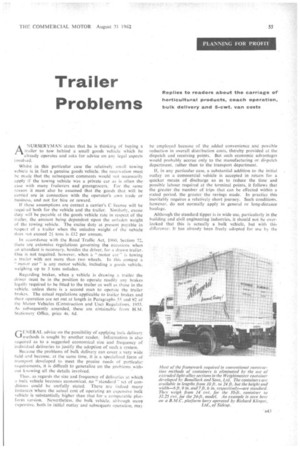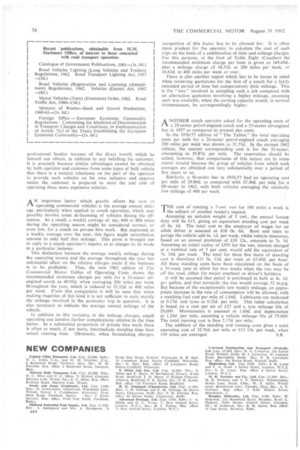Trailer Problems
Page 57

Page 58

If you've noticed an error in this article please click here to report it so we can fix it.
ANURSERYMAN states that he is thinking of buying a trader to tow behind a small goods vehicle which he already operates and asks for advice on any legal aspects i nvolv ed.
Whilst in this particular case the relatively small towing vehicle is in fact a genuine goods vehicle, the reservation must be made that the subsequent comments would not necessarily apply if the towing vehicle was a private car as is often the case with many fruiterers and greengrocers. For the same reason it must also be assumed that the goods that will be carried are in connection with the operator's own trade or business, and not for hire or reward. .
If these assumptions are correct a carrier's C licence will be required 'both for the vehicle and the trailer. Similarly, excise duty will be payable at the goods vehicle rate in respect of the trailer, the amount being dependent upon the unladen weight of the towing vehicle. The excise duty at present payable in respect of a trailer when the unladen weight of the vehicle does not exceed 21tons is i12 per annum.
In accordance with the Road Traffic Act, 1960. Section 72, there are extensive regulations governing the occasions when an atiendant is necessary, besides the driver, for a drawn trailer. One is not required. however, when a "motor car is towing a trailer with not more than two wheels. In this context a motor car" is any motor vehicle, including a goods vehicle. weighing up to 3 tons unladen.
Regarding brakes, when a vehicle is drawing a trailer the driver must be in the position to operate readily any brakes legally required to be fitted to the trailer as well as those in the vehicle, unless there is a second man to operate the trailer brakes. The actual regulations applicable to trailer brakes and their operation are set out at length in Paragraphs 55 and 92 of the Motor Vehicles (Construction and Use) Regulations, 1955. As subsequently amended, these are obtainable from H.M. Stationery Office, price 4s. 6d.
GENERAL advice on the possibility of applying balk delivery methods is sought by another reader. Information is also required as to a suggested economical size and frequency of individual deliveries to justify the adoption of such a system.
Because the problems of bulk delivery can cover a very wide field and because, at the same time, it is a specialized form of transport developed to Meet the precise needs of particular requirements, it is difficult to generalize on the problems without knowing all the details involved.
Thus, as regards the size and frequency of deliveries at which a bulk vehicle becomes economical, no "standard set of conditions could be usefully stated. There are indeed many instances where the actual cost of operating an expensive bulk vehicle is substantially higher than that for a comparable platform version, Nevertheless, the bulk vehicle, although more expensive, both in initial outlay and subsequent operation, may be employed because of the added convenience and possible reduction in overall distribution costs, thereby provided at the dispatch and receiving points. But such economic advantages would probably accrue only to the manufacturing or dispatch department, rather than to the transport department.
If, in any particular case, a substantial addition to the initial outlay on a commercial vehicle is accepted in return for a quicker means of discharge so as to reduce the time and possible labour required at the terminal points, it follows that the greater the number of trips that can be effected within a stated period, the greater the savings made. In practice this inevitably requires a relatively short journey. Such conditions. however, do not normally apply in general or long-distance haulage.
Although the standard tipper is in wide use, particularly in the building and civil engineering industries, it should not he overlooked that this is actually a bulk vehicle, but with this difference: It has already been freely adopted for use by the professional haulier because of the direct benefit which he himself can obtain, in addition to any befalling his customer. It is precisely because similar advantages cannot be obtained by both operator and customer from some types of bulk vehicle that there is a natural reluctance on the part of the operator to provide such vehicles on his own initiative and expense unless the customer is prepared to meet the real cost of operating these more expensive vehicles.
AN important factor which greatly affects the cost of operating commercial vehicles is the average annual mileage, particularly when applied to coach operation, which may possibly involve some de-licensing of vehicles during the offseason. As a result, a weekly average of, say, 600 or 800 miles during the operating season might be considered normal, or even low, for a coach on private hire work. But expressed as a weekly average over the year, this figure might nevertheless amount to only half that mileage. This point is brought out in reply to a coach operator's inquiry as to charges to be made in a particular instance.
This distinction between the average weekly mileage during the operating season and the average throughout the year has substantial effect on the relative charges made if the business is to be profitable. Thus, the new 1962 edition of The Commercial Motor Tables of Operating Costs shows the recommended minimum charges per mile for a 31-seater oilengined coach as 49.93d. when averaging 200 miles per week throughout the year, which is reduced to 32.32d. at 400 miles per week. From this comparison it will be seen that when making inquiries of this kind it is not sufficient to state merely the mileage involved in the particular trip in question. It is also necessary to indicate the average annual mileage of the vehicle.
In addition to this variation in the mileage charges, coach operating can involve further complications relative to the time factor. In a substantial proportion of private hire work there is often as much, if not more, intermediate standing time than actual running time. Obviously, when formulating charges,
recognition of this factor has to be allowed for. It is often more prudent for the operator. to calculate the cost of such trips on the basis of a combination of time and mileage charges. For this purpose, at the foot of Table Eight (Coaches) the recommended minimum charge per hour is given as 149.49d., plus a mileage charge of 18.53d. at 200 miles per week, or 16.61d. at 400 miles per week or over.
There is also another aspect which has to be borne in mind when tendering quotations for the hire of a coach for a fairly extended period of time but comparatively little mileage. This is the "loss" involved in accepting such a job compared with an alternative quotation involving a higher mileage, assuming such was available, when the earning capacity would, in normal circumstances, be correspondingly higher.
A NOTHER coach operator asked for the operating costs of rx a 29-seater petrol-engined coach and a 53-seater oil-engined bus in 1957 as compared to present day costs.
In the 1956/57 edition of " The Tables," the total operating costs per mile for a 26-seater petrol-engined coach averaging 200 miles per week was shown. as 3I.53d. In the current .1962 edition, the neatest corresponding cost is for the 31-seater, amounting to 35.87d. per mile. The reservation should be added, however, that comparisons of this nature are to some extent invalid because the group of vehicles from which such averages are obtained can vary substantially over a period of five years or so.
Similarly, a 56-seater bus in 1956/57 had an operating cost per mile of 29.84d, as compared with 37.30d. per mile for a 60-seater in 1962, with both vehicles averaging the relatively low mileage of 400 per week.
]T HE cost of running a 5-cwt. van for 100 miles a week is the subject of another reader's request. Assuming an unladen weight of 5 cwt., the annual licence duty will be £15, giving an equivalent standing cost per week of 6s. Id. The total cost to the employer of wages for an adult driver is assessed at £10 Os. 6d. Rent and rates to garage the vehicle add 8s. Id. per week, whilst vehicle insurance, based on an annual premium of £18 12s., amounts to 7s. 5d. Assuming an initial outlay of £393 for the van, interest charged at a nominal rate of 5 per cent. would add the equivalent of 7s. 10d. per week. The total for these five items of standing cost is therefore El I 9s. I Id. per week or 65.69d. per hour. All these standing costs have been calculated on the basis of a 50-week year to allow for two weeks when the van may be off the road, either for major overhaul or driver's holidays.
It will be assumed that petrol is purchased in bulk at 4s. Id. per gallon, and that normally the van would average 32 m.p.g. But because of the exceptionally low weekly mileage, an appropriate increase in the rate of consumption will be allowed, with a resulting fuel cost per mile of 1.84c1. Lubricants are reckoned at 0.17d. and tyres at 0.32d. per mile. This latter calculation is based_ on a cost per set of £27 and a tyre mileage life of 20,000. Maintenance is assessed at I.60d. and depreciation at 1.24d. per mile, assuming a vehicle mileage life of 75.000. The total running cost is thus 5.I7d. per mile.
The addition of the standing and running costs gives a total operating cost of 32.76d. per mile or £13 13s. per week, when
100 miles are averaged S.B.




























































































